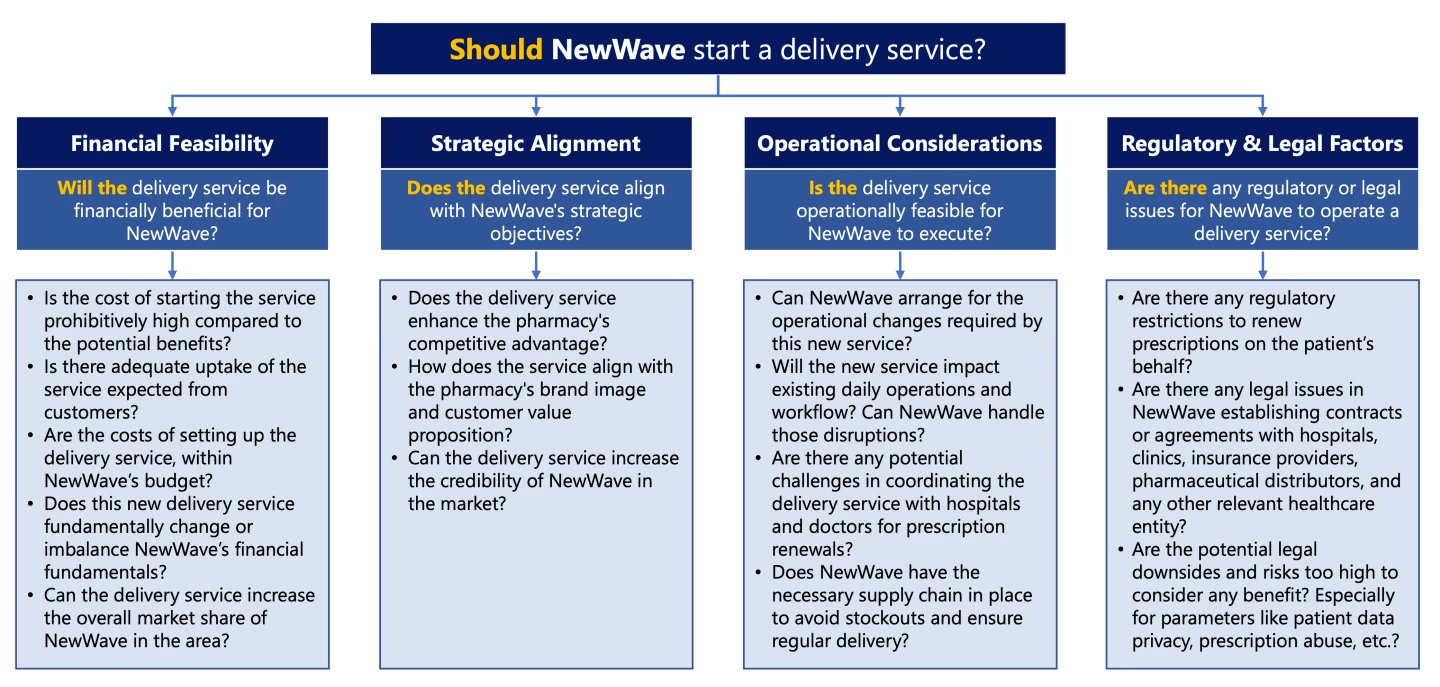Bain Final Round: Pharmacy Delivery Entry
Our client is a pharmacy in Dubai - called NewWave Pharmacy. This pharmacy wants to start a new & unique delivery service and want to understand if it is a good idea or not? If yes, then how should they price it? And how should they start it?
Case Comments
- This case is primarily designed for learning purposes and hence it is longer than typical interview cases
- It is recommended to do this case as a study session – instead of a mock interview practice. This will allow you to learn from the case more effectively by exploring the case elements in detail and without any time pressure.
- In order to take this case in a mock interview practice, it is advisable to focus on a limited portion of the case
- I would highly recommend to not try to “solve” this case. There is not right or wrong answer. Instead, try to understand the logic/rationale behind the case elements – and consequently develop your casing skills.
Clarifying Questions
Take 1-minute to write down 5-7 clarifying questions. Use the 4P and 3C frameworks to create intelligent clarifying questions
Sample clarifying questions, their rationale, and proposed answers from interviewer
Problem:
- Question: Why does NewWave want to launch this delivery service? What are their objectives?
- Answer from the interviewer: NewWave wants to offer an added layer of convenience to select customers with chronic prescriptions – by taking-over the task of prescription renewal
Product:
- Question: What are the products at NewWave Pharmacy? How do customers obtain them?
- Answer: Currently, the pharmacy has a mix of prescription medicines, over-the-counter drugs, and other general store goods (except for perishable food items). Customers can either get their medicines in-person from the pharmacy, or they call the pharmacy for on-demand free delivery.
Players:
- Question: Do other pharmacies in Dubai engage in delivery?
- Answer: The telephone based delivery is a common practice across all pharmacies in Dubai.
Profit formula:
- Question: What is the current profit margin for orders?
- Answer: Average margin is 30% for all orders.
Product:
- Question: How does NewWave Pharmacy envision the subscription delivery service to work?
- Answer: A chronic prescription patient will subscribe to this service by signing a contract and handing over their prescription to NewWave. This contract will enable NewWave to represent the patient in front of the doctor. Now on a monthly basis, the pharmacy will renew the prescriptions with the doctors/hospitals directly. And then deliver the medicines directly to the patients.
Price:
- Question: What is the typical price-range in NewWave’s mind for this delivery service?
- Answer: The pharmacy has not given this much thought yet – however they are open to start the service with zero charge as an introductory offer. At a later stage, they can start charging if it seems like a good idea. Can you also ascertain what kind of pricing would be best? The current on-demand delivery is free, with no minimum order.
Promotion:
- Question: Are there and additional channel costs and promotional activities expected? Such as registrations with the regulatory authority and insurance brokers?
- Answer: 5% of the medicine order value will need to be paid as regulatory fee to the Hospitals/Clinics and another 5% to the insurance providers.
Place:
- Question: How far will the delivery service extend?
- Answer: They are currently limiting the delivery radius to only 5km but will potentially increase it at a later stage if they find it to be successful.
Company:
- Question: Can you tell me some introductory facts about NewWave? Its age, customer base, market dominance etc.
- Answer: NewWave is standalone pharmacy in the old part of Dubai and is a few decades old – so it is well known in the area.
Customers:
- Question: Who are NewWave’s current customers and how many? What are their typical bill amounts?
- Answer: Currently NewWave Pharmacy serves around 1800 customers per month - 80% are non-chronic customers (average AED 125 per order) and 20% are chronic customers (average AED 250 per order).
Competition:
- Question: Are there any competitors around the area?
- Answer: There are around 10 pharmacies in a 5km radius – some standalone and some part of larger chains.
Additional Information
Linked to the sample clarifying questions – to be provided when asked by the candidate
- The case is based in 2000s and the pharmacy is standalone and a few decades old - so it is well known in the area.
- There are around 10 pharmacies in a 5km radius
- Currently, the customers either get their medicines in-person from the pharmacy, or they call the pharmacy for on-demand delivery. The delivery is free for all telephone orders (prescription and non-prescription) and there is no minimum order amount.
- The telephone-based delivery is a common practice across all pharmacies in Dubai
- A portion of this pharmacy’s customers are old patients with chronic prescriptions. These patients currently visit their doctor on a monthly basis to renew their prescription and then visit NewWave pharmacy to get their medicines.
- NewWave wants to offer more convenience to such customers by taking-up the tasks of prescription renewal and medicine delivery.
- The unique delivery system is envisioned to work as follows - a chronic prescription patient will subscribe to this service by signing a contract and handing over their prescription to NewWave. This contract will enable NewWave to represent the patient in front of the doctor. Now on a monthly basis, the pharmacy will renew the prescriptions with the doctors/hospitals directly. And then deliver the medicines directly to the patients.
- Currently NewWave Pharmacy serves around 1800 customers per month - 80% are non-chronic customers (average AED 125 per order) and 20% are chronic customers (average AED 250 per order) – with avg. margin of 30% for all orders
- The pharmacy anticipates that the launch of this new delivery service will double the number of chronic patients for their pharmacy. Although they are currently limiting the delivery radius to only 5km - potentially increasing it at a later stage if they find it to be successful.
- In order to operate this service, NewWave pharmacy will have to pay 5% of the total chronic patients’ revenue as fees to the Hospitals/Clinics and another 5% to the insurance providers.
- When it comes to delivery - NewWave has 2 options (let the candidate propose the options first).
- Option 1 is to hire a new dedicated delivery rider for AED 75,000 per annum, a bike for AED 4,000 per annum with fuel costs approximately AED 4,500 per annum. Hiring a new rider is necessary since the current delivery riders for the pharmacy are riding at full capacity. Note: Let the candidate come up with these numbers and assumptions themselves - using these items just to guide if necessary
- Option 2 is to hire a hyperlocal delivery provider that can provide this additional service. Based on their discussions, the typical fees asked by these delivery providers is 5% of order value
Learning Note
In this first section, we're setting the foundation for the entire case. The candidate is being evaluated on their ability to clarify the situation and ask relevant questions. It's important for the candidate to understand the case at hand, the client's objectives, and the market context. The recommended approach is to use a blend of commonly known basic frameworks (such as 4Ps and 3Cs) with customized questions specific to the case. These are well-structured frameworks that help ensure all critical aspects are covered and also shows the interviewer that you're taking a systematic approach.
Key Learnings & Tips:
- Identifying Key Objectives: NewWave's objectives were one of the first things we wanted to clarify. It's important to know what the client hopes to achieve from the onset because this will guide your analysis throughout the case. Remember that a company’s objectives might not always be financial.
- Contextual Understanding: The questions asked were not random. They were carefully chosen to give us a good understanding of the case context such as NewWave's current situation and the regulatory framework in Dubai. This contextual understanding is crucial for formulating a well-grounded recommendation later.
- Tailored Frameworks: While the 4P's and 3C's are generic frameworks, notice how they are customized to fit the specifics of the case. When preparing for case interviews, remember that frameworks are not meant to be used as-is. They need to be adapted to suit the case at hand.
- Thinking Ahead: Some questions are forward-looking and indicate what analyses we might have to do in the next stages.
- Engagement: The candidate's questions should encourage dialogue with the interviewer. Open-ended questions that seek information or opinions, rather than just a yes/no, allow for a richer conversation.
Remember, the goal of the clarifying questions is not just to ask questions for the sake of it but to provide a clearer direction for your case analysis. Your questions should demonstrate your logical thinking process and give the interviewer confidence in your structured approach.
Sample Structure
The main case question is the business decision of evaluating if the delivery service is a suitable initiative for NewWave. Evaluating a business decision not only involves looking at the direct financial benefits but also requires a holistic look at non-direct benefits, non-financial benefits, issues, challenges, and other considerations. Below, we have a step-by-step guide on how to structure your approach.
Instructions: Please take a time of 2-3 minutes to draw out your structure/framework. Once you have completed, take another 2 minutes to say it out aloud as if you were explaining it to the interviewer. These time limits are aligned with the expectations during an actual interview. Once you complete this exercise, proceed forward to see a sample framework solution. Your solution does not need to 100% match the sample solution – there is no right/wrong answer. Study the sample and see how you can improve you own solution
Suggested process for structuring
The main case question is the business decision of evaluating if the delivery service is a suitable initiative for NewWave. Evaluating a business decision not only involves looking at the direct financial benefits but also requires a holistic look at non-direct benefits, non-financial benefits, issues, challenges, and other considerations. Below, we have a step-by-step guide on how to structure your approach.
- Step 1: Identify top-level pillars
- Step 2: Formulate high-level hypothesis for each pillar
- Step 3: Generate solution hypotheses for each pillar
- Step 4: Identify information requirements to validate hypotheses
Step 1: Identify top-level pillars

Start by identifying the fundamental areas that need analysis. In decision-based cases like this, the evaluation is best structured around four core pillars—Finance, Strategy, Operations, and Legal. You can choose a different set of pillars as well if you like. This classification provides a holistic coverage of the pharmacy’s activities and ensures the decision-making process is comprehensive. Your top-level breakdown can include:
- Financial Feasibility
- Strategic Alignment
- Operational Considerations
- Regulatory and Legal Factors
Step 2: Formulate high-level hypothesis for each pillar

For each pillar, devise a high-level hypothesis that aims to answer the overall case question of whether the delivery service is a good idea or not:
- Financial Feasibility: Will the delivery service be financially beneficial for NewWave?
- Strategic Alignment: Does the delivery service align with NewWave’s strategic objectives?
- Operational Considerations: Is the delivery service operationally feasible for NewWave to execute?
- Regulatory and Legal Factors: Are there any regulatory or legal issues for NewWave to operate a delivery service?
Step 3: Generate solution hypotheses for each pillar
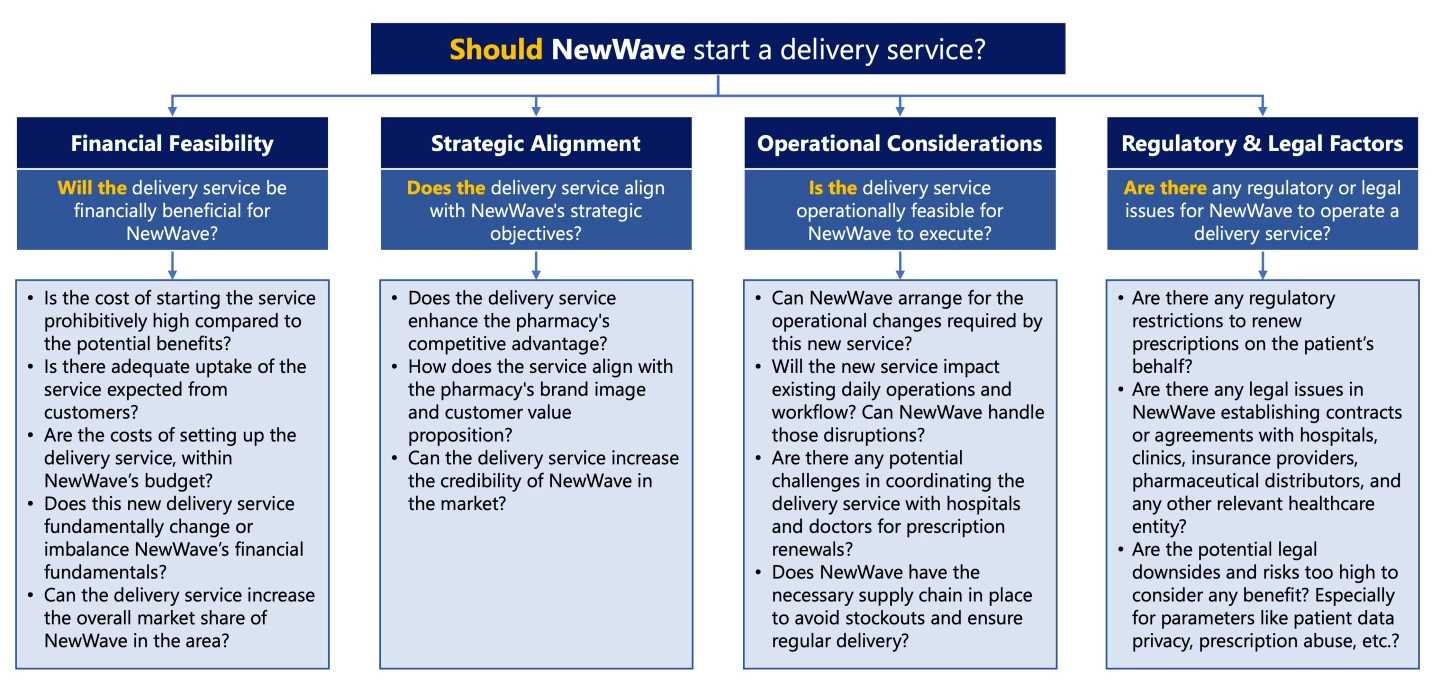
Think of each hypothesis as a mini question that needs to be answered to answer the high-level question. Leverage first-principle thinking by breaking down each high-level question into the foundational assumptions or facts that would need to be true for the answer to the high-level question to be a "yes". Here's how you might generate these hypotheses:
- Financial Feasibility: Will the delivery service be financially beneficial for NewWave?
- Is the cost of starting the service prohibitively high compared to the potential benefits?
- Is there adequate uptake of the service expected from customers?
- Are the costs of setting up the delivery service, within NewWave’s budget?
- Does this new delivery service fundamentally change or imbalance NewWave’s financial fundamentals?
- Can the delivery service increase the overall market share of NewWave in the area?
- Strategic Alignment: Does the delivery service align with NewWave’s strategic objectives?
- Does the delivery service enhance the pharmacy's competitive advantage?
- How does the service align with the pharmacy's brand image and customer value proposition?
- Can the delivery service increase the credibility of NewWave in the market?
- Operational Considerations: Is the delivery service operationally feasible for NewWave to execute?
- Can NewWave arrange for the operational changes required by this new service?
- Will the new service impact existing daily operations and workflow? Can NewWave handle those disruptions?
- Are there any potential challenges in coordinating the delivery service with hospitals and doctors for prescription renewals?
- Does NewWave have the necessary supply chain in place to avoid stockouts and ensure regular delivery?
- Regulatory and Legal Factors: Are there any regulatory or legal issues for NewWave to operate a delivery service?
- Are there any regulatory restrictions to renew prescriptions on the patient’s behalf?
- Are there any legal issues in NewWave establishing contracts or agreements with hospitals, clinics, insurance providers, pharmaceutical distributors, and any other relevant healthcare entity?
- Are the potential legal downsides and risks too high to consider any benefit? Especially for parameters like patient data privacy, prescription abuse, etc.?
- Is there adequate legal assistance available for NewWave to manage the legal risk above?
By the end of this process, you should have a comprehensive framework that will guide your analysis of whether NewWave should start the delivery service. The next step is to gather the necessary data to test each hypothesis. The elements you identify in step 4 will inform you on the key data items you need to examine.
Step 4: Identify information requirements to validate hypotheses
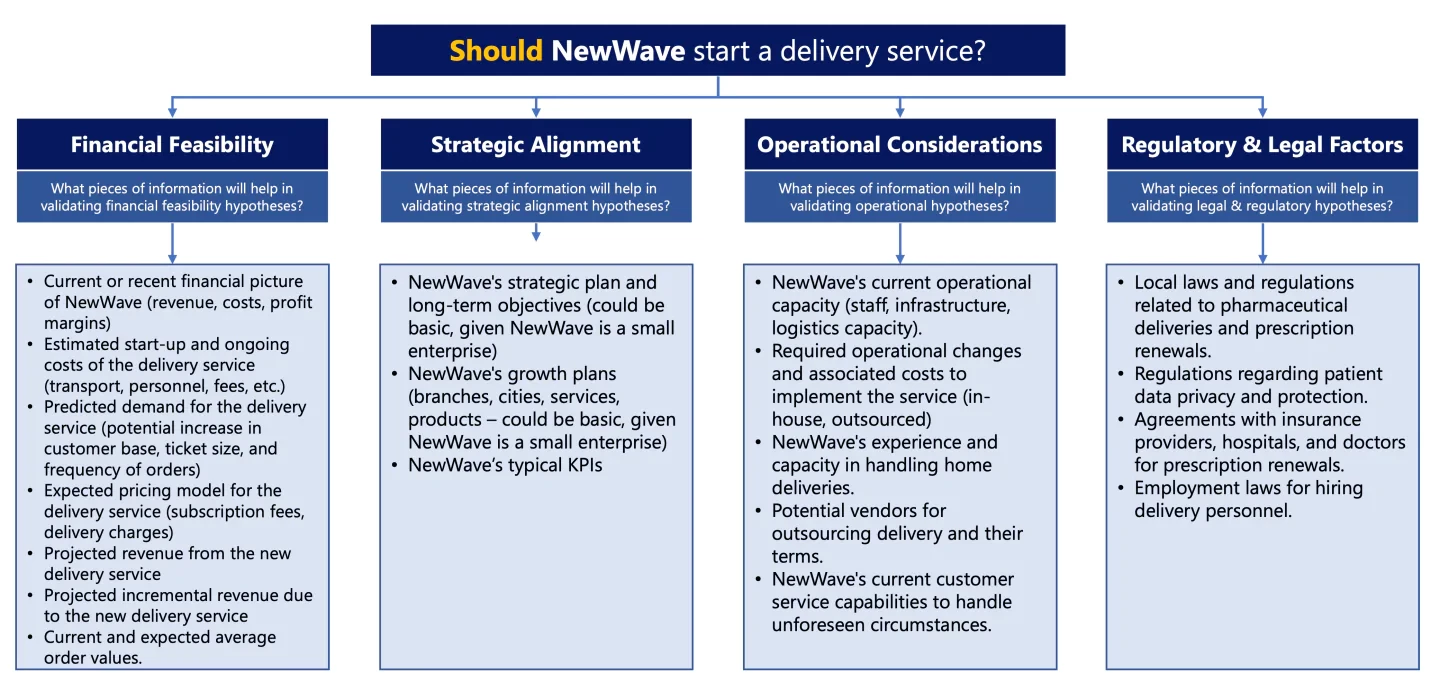
Once the framework is laid out, candidates need to conduct their analysis and provide a solution based on the framework. Most candidates find it challenging to ask the interviewer for specific data points or exhibits. This problem arises primarily because their frameworks are not hypotheses-based. With your hypotheses-based framework it becomes easier to identify the pieces of information you need analyses and resolve the hypotheses. Here's an example of how to do this for each pillar:
Financial Feasibility: The information elements here will help in calculating the financial impact of this decision. Elements such as estimated costs and projected demand will help quantify the direct financial benefit, while others such as estimated costs will assist in understanding the overall return on this investment.
- Current or recent financial picture of NewWave (revenue, costs, profit margins)
- Estimated start-up and ongoing costs of the delivery service (transport, personnel, fees, etc.)
- Predicted demand for the delivery service (potential increase in customer base, ticket size, and frequency of orders)
- Expected pricing model for the delivery service (subscription fees, delivery charges) and
- Projected revenue from the new delivery service
- Projected incremental revenue due to the new delivery service
- Current and expected average order values.
Strategic Alignment: These information elements serve to validate the strategic fit of this initiative with NewWave’s current strategy. Understanding current marketing activities, customer profile, and potential synergies with other products and services will allow a thorough assessment of the initiative's strategic alignment.
- NewWave's strategic plan and long-term objectives (could be basic, given NewWave is a small enterprise)
- NewWave's growth plans (branches, cities, services, products – could be basic, given NewWave is a small enterprise)
- NewWave’s typical KPIs
Operational Considerations: Operational elements are necessary to understand what changes NewWave will need to make to its operations and whether it has the resources to make these changes. These elements will highlight potential operational challenges and requirements.
- NewWave's current operational capacity (staff, infrastructure, logistics capacity).
- Required operational changes and associated costs to implement the service (in-house, outsourced)
- NewWave's experience and capacity in handling home deliveries.
- Potential vendors for outsourcing delivery and their terms.
- NewWave's current customer service capabilities to handle unforeseen circumstances.
Regulatory and Legal Factors: The elements here help understand the legal and regulatory landscape that NewWave is entering. From understanding the contractual obligations and restrictions to assessing potential negative publicity, these elements will guide NewWave in understanding the potential risks involved in starting a delivery service.
- Local laws and regulations related to pharmaceutical deliveries and prescription renewals.
- Regulations regarding patient data privacy and protection.
- Agreements with insurance providers, hospitals, and doctors for prescription renewals.
- Employment laws for hiring delivery personnel.
Profitability Analysis of the Delivery Service
After outlining the framework in the previous section, the candidate should proceed towards estimating the financial feasibility of the new delivery service.
Analysis approach
The first part of any analysis is the convey the correct analysis approach. A suggest approach is the following:
- Step 1: Estimate the current profits for NewWave (split by non-chronic and chronic customers)
- Step 2: Estimate the incremental revenue and margin based on additional customers
- Step 3: Estimate the incremental costs for setup and operations of the new delivery service
- Step 4: Estimate the projected net profits considering incremental revenue and costs in Step 2/3
- Step 5: Evaluation of the opportunity
Step 1: Current profits
Analysis approach
- Step 1.1: Revenue for a pharmacy is number of customers multiplied by average customer bill
- Step 1.2: Profit is the margin percentage multiplied by the revenue

Model Response:
- We are first estimating the current profit for NewWave pharmacy
- Using the profit formular, we understand that profit will be the average margin percentage multiplied by the revenue
- And the revenue can be estimated by multiplying number of customers by the average bill per customer
- NewWave has 1800 customers per month with 80% (or 1,440 non-chronic), and 20% (or 360 chronic patients)
- The average bill for non-chronic customers is AED 125, and is AED 250 for chronic patients
- …doing math…
- So, 1,440 into 125 and 360 into 250 give us AED 2.16M and AED 1.08M – for total revenue of AED 3.24M monthly
- Since the profit margin is 30% average across all orders regardless of chronic or non-chronic, we multiply the revenue by it straightaway to get AED 972,000 of monthly profit
- We understand that the 30% margin is inclusive of all costs – so that is quite a healthy margin for NewWave
Step 2: Incremental Revenue and Profit
Analysis approach:
- Step 2.1: Understand additional projected customers joining NewWave Pharmacy
- Step 2.2: Calculate new total revenue and new profit similar to step 1 with new customer base (note that this profit will not be taking into account the costs related to this new delivery service – so it is not the final new profit)
- Step 2.3: Calculate the incremental profit (again, devoid of considering the delivery related incremental costs)

Model Response:
- We understand that the pharmacy anticipates a doubling of the number of chronic patients due to the new service
- This means that there will be 720 chronic patients per month instead of 360
- Taking a similar approach to our first step … doing math … we get a total revenue of AED 4.32M for a margin of AED 1.296M – although this doesn’t consider incremental costs of the delivery service
- The total incremental margin is AED 324,000 (1.296 minus 0.972)
- We see that the contribution from non-chronic customers remains the same, while that from chronic patients has doubled, in line with the number of customers
Delivery Option 1 - Step 3/4: Incremental Costs and net profit
- Delivery costs
- Rider cost (salary) – estimated to be about AED 75,000 per year, all-in. Hiring a new rider is necessary since the current delivery riders for the pharmacy are riding at full capacity
- Bike cost (buy) – estimated to be about AED 4,000 for the first year
- Bike cost (fuel, maintenance, etc.) – we could go into a detailed estimation exercise as well, however, in the interest of time we could take a high-level cut at around AED 450 per month or about AED 5,400 per year
- Other costs
- Hospital fees – 5% of chronic patient revenue (5% of AED 2.16M)
- Insurance fees – 5% of chronic patient revenue (5% of AED 2.16M)


Model Response:
Putting everything together, we see that total incremental costs for the delivery service turn out to be AED 300,400. Given the incremental margin of AED 324,000 in step 2, the net incremental margin is AED 23,600, and potentially AED 27,600 from year 2 onwards since the bike cost is one-time. This means that the delivery service is a financial viable option with hiring the delivery rider in option 1.
Delivery Option 2 - Step 3/4: Incremental Costs and net profit
- Delivery costs – 5% of chronic patient revenue (5% of AED 2.16M)
- Other costs
- Hospital fees – 5% of chronic patient revenue (5% of AED 2.16M)
- Insurance fees – 5% of chronic patient revenue (5% of AED 2.16M)


Putting everything together, we see that total incremental costs for the delivery service turn out to be AED 324,000, netting off the incremental margin of AED 324,000 calculated in step 2. While being a financial less viable option than option 1, it is still not a financial non-viable option with an incremental profit of Zero.
Evaluation of the delivery service opportunity
When we evaluate this deal based on our framework through the lenses of Financial, Strategic, Operational, and Legal pillars; we get an overall promising recommendation
Evaluation based on framework – for learning
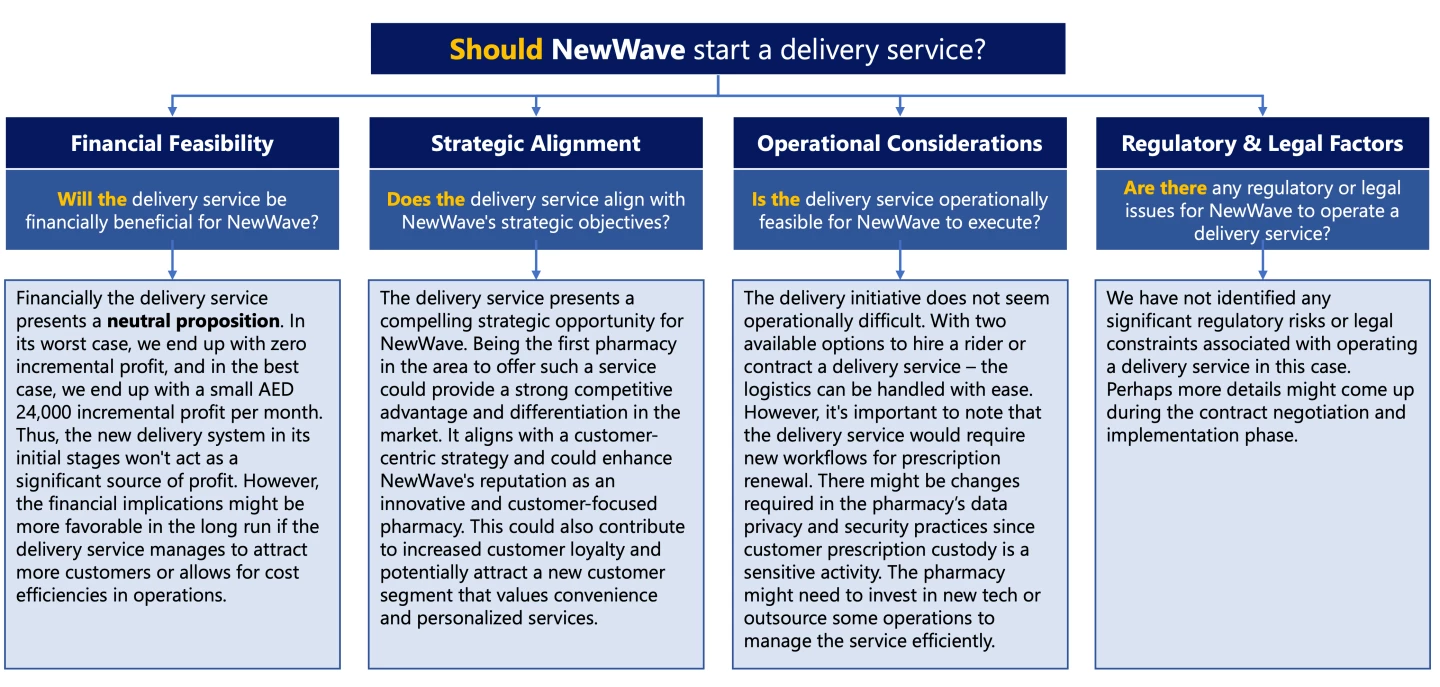
Final Recommendation
While the financial projections indicate that the service might not significantly contribute to the pharmacy's profits in the short term, it's important to consider the strategic value of this initiative. Being the first to offer such a service in the market can greatly enhance NewWave Pharmacy's competitive positioning, create a distinctive reputation, and increase customer loyalty. Moreover, the potential increase in the customer base, especially among chronic patients, could yield financial benefits in the longer term. It's recommended to start with a carefully controlled launch, perhaps focusing on a segment of their chronic patients to manage costs and monitor the operational implications closely.
Learning note
In this case, we've dealt with financial analysis of a new initiative. This is a key part of case interviews that tests your ability to understand data, develop analysis approaches, and execute the analysis to reach conclusions:
Key Coaching Tips:
- Mastering Data analysis: I can't stress enough the importance of being comfortable with data. In this case analysis there was a fair bit of math involved. The ability to calculate all the financial numbers is essential. What is more important is that the financial concepts you present, are sound, and simple.
- Approach Analysis in Layers: Notice how the candidate is expected to analyse the calculations step-by-step, starting with conceptual approach and moving to complex math. As you practice your cases, I encourage you to think about data in these layers. It will help you handle complex calculations with ease and not get bogged down.
- Connection is Key: Connecting the dots between different pieces of data is crucial. In this case, the candidate could correlate data from various answers by the interviewer to create a holistic analysis. I want you to remember this during your case preparations. Always try to connect your data and calculations back to the main question or problem at hand.
- Stick to Your Framework: A good way to structure your case is by adhering to your initial problem-solving framework. In this section, you saw how the candidate connected their final evaluation and recommendation back to the initial framework (Financial, Strategic, Operational, Legal). This consistency is important to demonstrate in your case interviews.
- Communication Matters: It's not enough to do a great analysis; you also have to present it well. I want you to practice presenting your findings and recommendations in a clear, concise, and articulate manner, explaining the rationale behind your conclusions.
- Be Realistic: Note how the candidate remained pragmatic in their recommendation. Despite recommending proceeding with the delivery initiative, they acknowledged that more details might surface during the contract implementation. In your cases, always maintain a balanced perspective, taking into account the inherent uncertainties in business decisions.
As you continue to prepare for your case interviews, keep these coaching tips in mind. Practice not just your problem-solving skills but also your data interpretation, synthesis, and communication abilities. Don't forget to use the layered analysis approach to derive deeper insights from data. Keep practicing, and you'll get there!
Determining the Pricing
Now that we have assessed the opportunity and deemed it beneficial for NewWave, the next step is to determine an appropriate pricing model. This calculation requires a consideration of various financial and strategic factors.
Step 1: Identify the Streams of Benefits and Losses
Our first step is to identify the streams of potential benefits and challenges from this deal. Here are the main ones:
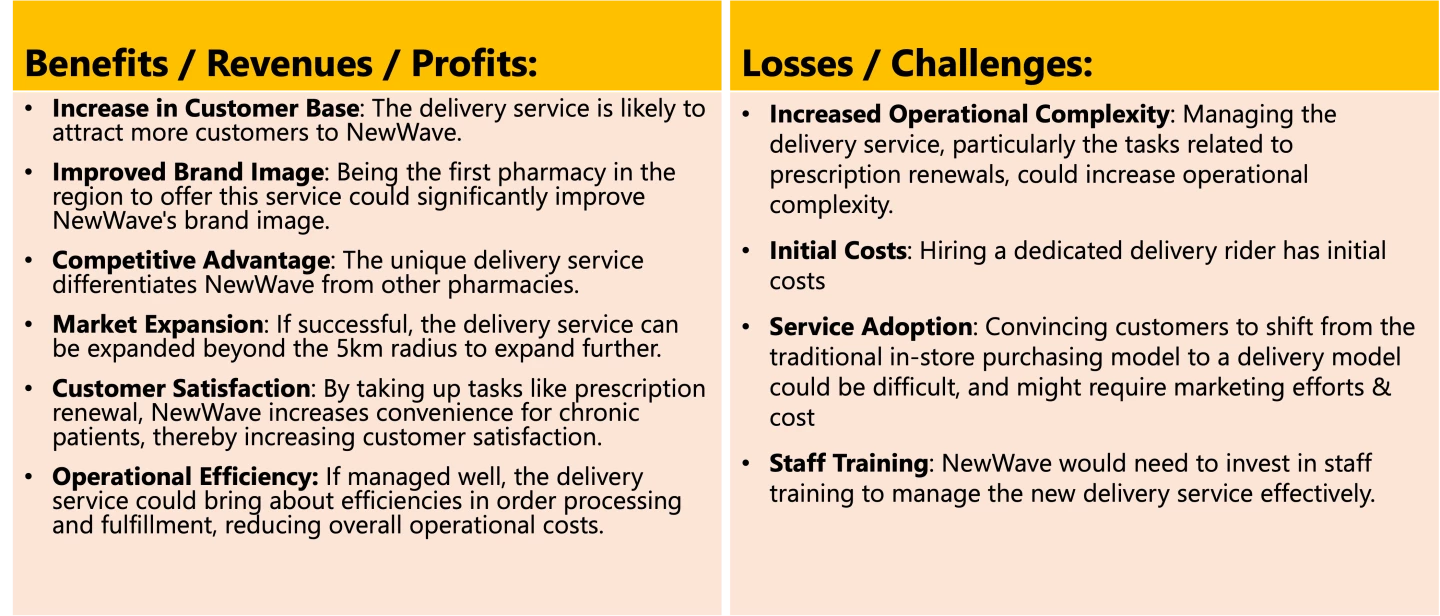
Step 2: Identify Various Analysis Approaches and Eliminate the Unsuitable
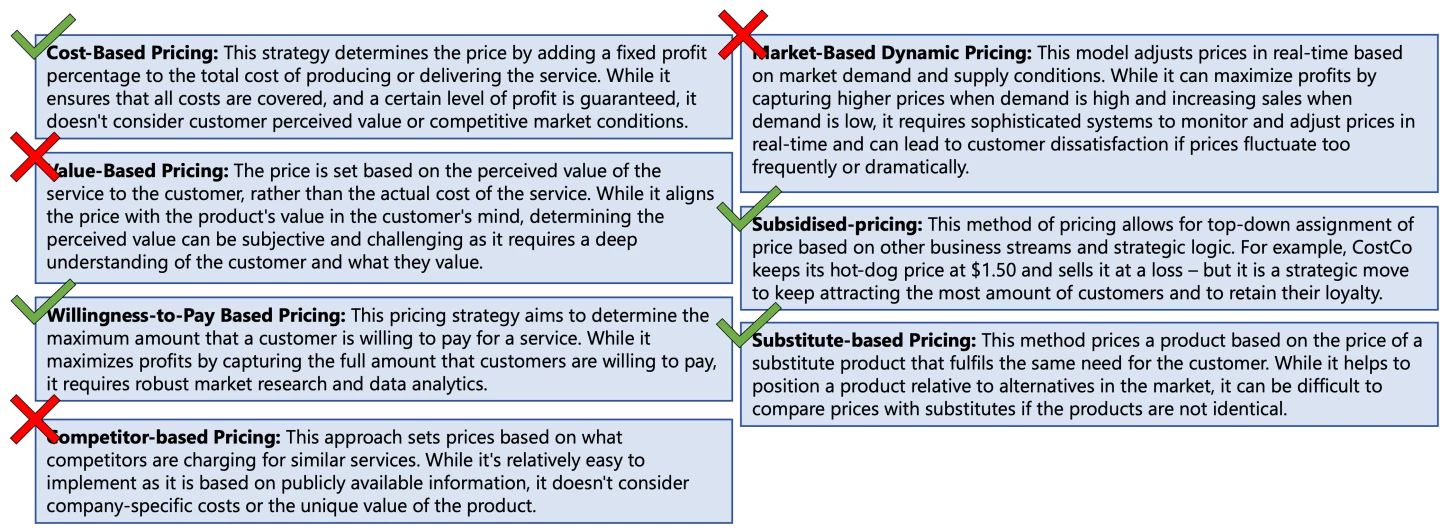
Model Explanation and Answer:
- Overall, there are about 6-7 different way to price a product or a service – cost-based, value-based, willingness-to-pay, competitor-based, substitute-based, and market-based.
- Competitor-based pricing is not relevant since this is a new offering in the market
- Market-based pricing (e.g. bid-action) can also be eliminated since it's unpredictable and requires sophisticated systems to track and adjust prices based on demand, which might be difficult to manage for a single, small-scale pharmacy.
- Value-based pricing and willingness-to-pay based pricing would require initial market testing with customers. Due to lack of that information right now, we can park them on the side for the moment.
Step 3: Conduct Analysis and assessment
The next step is to identify approximate pricing levels based on the remaining applicable pricing methodologies.
Cost-Based Pricing:
- In this method, we identify the average added cost of providing the delivery service, add a mark-up, and add all of that to the customer’s bill or monthly fee charge.
- As an example, for option 1, we have AED 75,000 + AED 5,400 = AED 80,400 per year (or about AED 6,700 per month) of fixed cost, with 10% of the bill value going as fees to the hospital and insurance companies.
- The AED 6,700 of fixed cost gets spread across the 720 chronic patient orders at approx. AED 9.3 per order
- The hospital and insurance fees at 5% each per bill total to AED 25 per order
- The total cost is AED 34.3 or approx. AED 35 per month plus whatever margin we might choose to add
- For option 2, the cost of delivery is 5% of order amount, while the hospital and insurance fees are also 5% each. Hence the total cost is 15% of the order value
- Given the average order size of AED 250, this comes to AED 37.5 per month plus our chosen margin
- Both options give us a monthly fee of approximately AED 35 and above. While this may be financial good for us, it is surely a sizeable fee charge for the chronic customers. We need to check if they would be willing to pay this amount.
Substitute-Based Pricing:
- In this method, we will identify the prices of substitute to this delivery service.
- At this point, the major substitute is basically the customer going themselves to the clinic and getting the prescription renewed. Thereafter, they can call NewWave and get a free on-demand delivery of their medicines.
- The typical cost for a customer to go to the doctor and renew prescription needs to be estimated.
- For a 5-10km travel, the average fuel cost would be AED 5-10 per monthly trip, while the time cost could also be significant for the wealthier patients.
- Hence, any fee more than AED 10 per month, and most customers would not find it beneficial compared to their ongoing approach.
Subsidized pricing – e.g. free of charge:
- Since the upper-end of the fees is not at AED 10, we might as well consider making if free-of-charge. This is the case in assumed in the calculations by-default.
- While free pricing will be financially the most difficult for the pharmacy to absorb, it will ensure guaranteed uptake of the service by our customers and will also lead to the expected doubling of chronic patients as many would move from their existing pharmacy as well
- Additionally, keeping the service free would mean that other competitors wishing to enter the game would not be able to play on price and will have to innovate in order to develop any further competitive edge
Model Explanation of the evaluation
“Comparing the above relevant pricing methodologies, it seems that keeping the delivery service free-of-charge seems like a strategically sound, but financial difficult decision. However, as we see in the financial analysis section – despite offering a free service, we still break-even on the initiative in the worst case scenario. Keeping the service free of a charge serves the benefit of attracting customers and keeps the added service on par with regular delivery as well.”
Learning Note
This section discussed the complex problem of determining the best pricing strategy for NewWave's proposed delivery service. This stage tests your skills in financial modelling, critical reasoning, and strategic thinking.
Key learning tips:
- Quantitative Skills and Financial Modeling: This section emphasizes the importance of being comfortable with numbers and financial analysis. Your ability to accurately determine pricing methodologies and calculate them is a crucial asset in case interviews. Remember, the choice of the pricing methodology should also be justified based on the context of the case.
- Strategic Approach: Besides mathematical calculations, the candidate also factored in non-financial items and potential synergies that could affect the deal. This involves a layer of strategic thinking beyond numerical analysis. Always remember, the best recommendations often come from a blend of quantitative analysis and qualitative factors. So, always consider the strategic implications of your analysis.
- Presenting your Recommendation: After performing the analysis, the candidate had to present a clear and informed recommendation. While your calculations and analysis are crucial, your communication skills are equally important. Practice articulating your recommendations effectively, ensuring to clarify the rationale behind your conclusions.
- Reflection and Improvement: After completing the case, reflect on your approach. Identify areas where you struggled and work on improving those skills. Did you find the financial analysis challenging? Were you unsure about some assumptions? Were there strategic aspects you overlooked? Reflecting on these questions will help you understand where to focus your efforts in improving.
Remember, mastering case interviews involves building a diverse set of skills, including quantitative analysis, strategic thinking, making reasonable assumptions, effective communication, and risk assessment. By practicing these aspects, you can significantly improve your case interview performance.
Brainstorming to build on the service
Ideas
As NewWave moves towards launching this delivery service, it's crucial to identify various additional growth opportunities. The following are some ideas to build on this service. These ideas aim to add value to the delivery service. A successful implementation of these strategies would require continuous investment and product refinement from NewWave according to customer feedback.
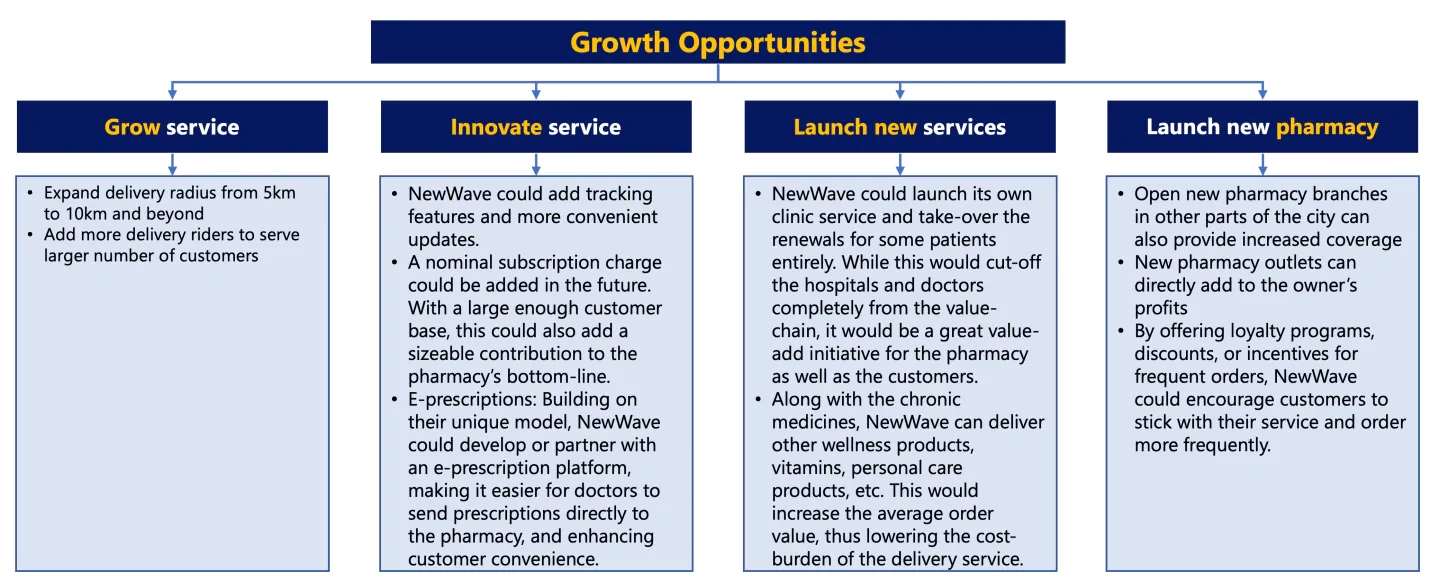
Learning note
This section explored potential growth opportunities for NewWave Pharmacy by leveraging their new delivery service. The process involved brainstorming various pathways to enhance and expand upon the proposed service, formulating potential strategies for further business growth and increased competitiveness.
Key learning tips:
- Creative Problem Solving: The ability to think outside the box and brainstorm unique solutions to problems is crucial. Remember, there is often more than one way to achieve a goal, and the ability to conceive unconventional approaches can differentiate you in case interviews.
- Strategic Thinking: The candidate had to think in terms of the bigger picture. Understanding how a single decision can unfold into multiple growth avenues can help in formulating robust, long-term strategies.
- First-principle based structured thinking: Just like in the main case framework, approach the brainstorming with a systematic approach can help break down the challenging task of devising new ideas to something much more manageable. Here we see that the structure splits into growing the service, innovating the service, launching new services, and launch new pharmacy. The scope for each pillar builds on the previous one. This approach allows the candidate to cover the full spectrum of potential ideas.
- Presenting your Recommendation: Just like in the previous sections, clear articulation of your thought process is key. While brainstorming, make sure to communicate your ideas effectively, explaining how each potential opportunity could be actualized and its possible impact on the business.
Keep these points in mind as you brainstorm for additional suggestions for both this case and additional cases in the future. All the best!
Case Conclusion
Sample response
Thank you for the opportunity to evaluate this initiative by NewWave Pharmacy. We understand that NewWave is a standalone multi-decade-old pharmacy in old Dubai. The pharmacy intends to expand its delivery service for chronic patients with a unique proposition to take-over the task of prescription renewals. We were tasked with evaluating the initiative, and identifying the implementation practicalities.
Over the course of our discussion, I have examined the potential delivery service from various angles and found it to be a very beneficial initiative:
- Financially, the delivery service is not a loss-making venture, and it only likely to result in a growing business over time. The worst-case scenario projects a break-even despite keeping the service free-of-charge. This is highly encouraging and definitely worth a try for the client.
- Strategically, the service can add a lot of customer satisfaction and innovation credo for our client. With a first mover advantage, a well-executed initiative can be a good blow to the competitors while garnering strong customer satisfaction and loyalty, particularly among chronic patients.
- Operationally, the initiative is not challenging to implement or operate. Additional resourcing requirements are easy to acquire and are well within budget. We can either hire a delivery rider or contract a delivery service partner. There would be some costs associated with each of these options, but they appear to be manageable.
- Finally, from a legal and regulatory perspective, there seem to be no prohibitions on implementing this service, so it appears feasible from that standpoint as well. We would come to know more details as we go into contract negotiation and implementation stages.
I recommend NewWave to proceed with implementing the delivery service initiative. I would also advise them to carefully consider the pricing model – leaning towards a free of charge concept initially to attract more customers. In terms of which delivery options, they might want to start with contracting the delivery company to keep their initial costs very low and grow as they scale-up.
In terms of next steps, if NewWave chooses to proceed, they should:
- Conduct a market research study to validate assumptions about the perceived value of such a service
- Develop a detailed operational plan for implementing the service, including choosing a delivery option and establishing processes for renewing prescriptions and managing deliveries.
- Establish processes needed for handling returns, complaints, and additional customer service issues.
- Engage with legal counsel to ensure they are in full compliance with all relevant regulations and conduct a thorough financial analysis to determine the optimal pricing strategy.
Learning note
The wrap-up is your opportunity to bring all the pieces of the analysis together and present your final conclusions and recommendations. It is crucial to do this in a clear and concise manner, demonstrating your ability to synthesize the information and insights you have gathered throughout the case. Here's a guide to help you perform the case wrap-up effectively:
- Summarize the Situation and Your Analysis: Start by briefly summarizing the case situation and the main points of your analysis. You should touch upon the client's background, the opportunity they're considering, and the key insights from the data you've examined.
- Present Your Conclusion: Based on your analysis, provide a clear statement of your conclusion. In this case, whether or not NewWave should start a delivery service. Ensure that your conclusion is logically derived from the analysis and insights you've shared.
- Recommendations: Following your conclusion, you should provide some concrete recommendations for the client. In the context of this case, this could include the recommended pricing strategy, key deal terms to consider, and potential next steps if NewWave decides to go ahead with the opportunity.
- Link Back to Framework: Throughout your wrap-up, make sure to link your conclusions and recommendations back to the framework you've established earlier in the case. This helps demonstrate the structured thinking behind your analysis and conclusions.
- Communicate Clearly: Above all, your wrap-up should be clear and easy to understand. Remember, the purpose of the wrap-up is to show that you can pull together your findings into a coherent whole and communicate them effectively to your 'client'.
Keep these points in mind as you perform the wrap-up for this case and any other case you tackle in the future. Good luck.
How to Build a Good Structure
Discover why clear structuring is crucial in case interviews and how you can enhance this skill.
GROW Model
Master the GROW model to structure your case interviews and boost your consulting career with clarity, strategy, and confidence.
Growth Strategy
Learn how to develop effective growth strategies in case interviews. Discover key factors for revenue growth and boost your chances of success!
Kotter Change Management Model
The 8-Step Model serves as a roadmap to guide organizations through change initiatives. Learn about each step and how it can help to transform your business.
The Tuckman Model
Tuckman's model outlines five fundamental stages of group development, namely: forming, storming, norming, performing, and adjourning. Learn what they mean!

